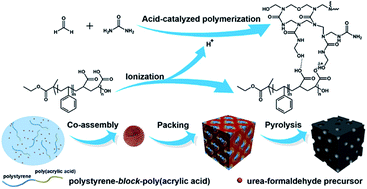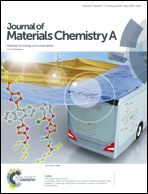A template-catalyzed in situ polymerization and co-assembly strategy for rich nitrogen-doped mesoporous carbon†
Abstract
N-doped mesoporous carbon materials are greatly useful in adsorption, catalysis and energy storage. Controlled synthesis of such materials with both high nitrogen content and desired pore structures remains a great challenge. Herein, we report a new template-catalyzed in situ polymerization and co-assembly approach to synthesize rich N-doped and uniform mesoporous carbons by using urea-formaldehyde (UF) as a carbon precursor and nitrogen source, and the acidic block copolymer polystyrene-block-poly(acrylic acid) (PS-b-PAA) as both a structure-directing agent and a catalyst for UF resin. In this synthesis, UF precursors can selectively interact with partially ionized PAA segments via hydrogen bonding and electrostatic interaction, and subsequently in situ polymerize to form bulk UF resin/PS-b-PAA composites by the catalysis of acidic PAA segments. After pyrolysis at 600 °C in nitrogen, the resulting N-doped mesoporous carbons possess high N content (up to ∼19 wt%), high ratio of basic species (∼49% pyridinic nitrogen and ∼28% pyrrolic nitrogen), uniform and large pore size (9.5–17.2 nm) and high surface area (458–476 m2 g−1). Owing to such unique features, the N-doped mesoporous carbons show high normalized CO2 adsorption capacity (4.71–5.15 μmol m−2) and excellent selectivity (60 : 1–67 : 1) to CO2 compared to N2 at 298 K and 1.0 bar, and exhibit excellent performance as a supercapacitor electrode with a high specific capacitance (239–252 F g−1).



 Please wait while we load your content...
Please wait while we load your content...